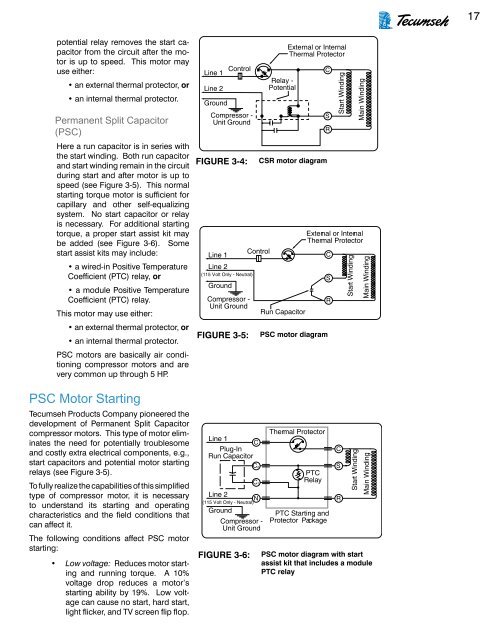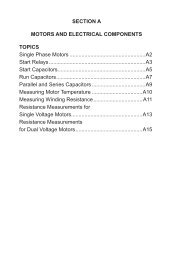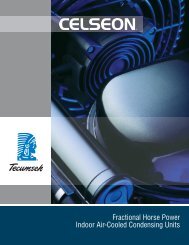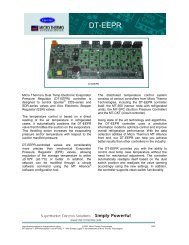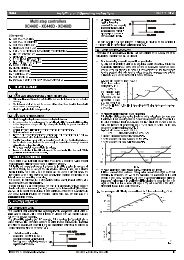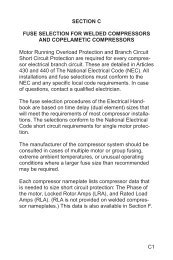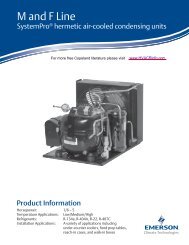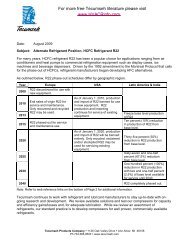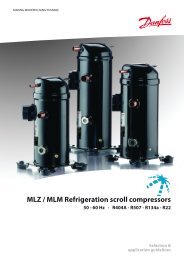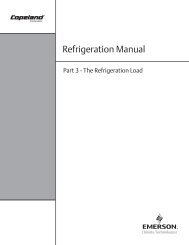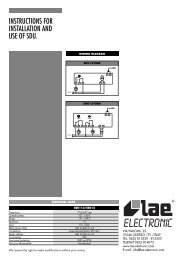Hermetic Compressor - Tecumseh
Hermetic Compressor - Tecumseh
Hermetic Compressor - Tecumseh
You also want an ePaper? Increase the reach of your titles
YUMPU automatically turns print PDFs into web optimized ePapers that Google loves.
17<br />
potential relay removes the start capacitor<br />
from the circuit after the motor<br />
is up to speed. This motor may<br />
use either:<br />
• an external thermal protector, or<br />
• an internal thermal protector.<br />
Permanent Split Capacitor<br />
(PSC)<br />
Here a run capacitor is in series with<br />
the start winding. Both run capacitor<br />
and start winding remain in the circuit<br />
during start and after motor is up to<br />
speed (see Figure 3-5). This normal<br />
starting torque motor is sufficient for<br />
capillary and other self-equalizing<br />
system. No start capacitor or relay<br />
is necessary. For additional starting<br />
torque, a proper start assist kit may<br />
be added (see Figure 3-6). Some<br />
start assist kits may include:<br />
• a wired-in Positive Temperature<br />
Coefficient (PTC) relay, or<br />
• a module Positive Temperature<br />
Coefficient (PTC) relay.<br />
This motor may use either:<br />
• an external thermal protector, or<br />
• an internal thermal protector.<br />
PSC motors are basically air conditioning<br />
compressor motors and are<br />
very common up through 5 HP.<br />
PSC Motor Starting<br />
<strong>Tecumseh</strong> Products Company pioneered the<br />
development of Permanent Split Capacitor<br />
compressor motors. This type of motor eliminates<br />
the need for potentially troublesome<br />
and costly extra electrical components, e.g.,<br />
start capacitors and potential motor starting<br />
relays (see Figure 3-5).<br />
To fully realize the capabilities of this simplified<br />
type of compressor motor, it is necessary<br />
to understand its starting and operating<br />
characteristics and the field conditions that<br />
can affect it.<br />
The following conditions affect PSC motor<br />
starting:<br />
• Low voltage: Reduces motor starting<br />
and running torque. A 10%<br />
voltage drop reduces a motor’s<br />
starting ability by 19%. Low voltage<br />
can cause no start, hard start,<br />
light flicker, and TV screen flip flop.<br />
Line 1<br />
Line 2<br />
Ground<br />
Control<br />
<strong>Compressor</strong> -<br />
Unit Ground<br />
FIGURE 3-4:<br />
FIGURE 3-5:<br />
FIGURE Line 1 3-6:<br />
Line 2<br />
Control<br />
Ground<br />
<strong>Compressor</strong> -<br />
Unit Ground<br />
Control<br />
Line 1<br />
Relay -<br />
Potential<br />
External or Internal<br />
Thermal Protector<br />
CSR motor diagram<br />
Start Winding<br />
Main Winding<br />
External or Internal<br />
Thermal Protector<br />
Line 1<br />
Control<br />
C<br />
Line 2<br />
S<br />
Ground<br />
<strong>Compressor</strong> -<br />
External R or Internal<br />
Unit Ground<br />
Thermal Protector<br />
Run Capacitor<br />
Control<br />
Line 1<br />
C<br />
Line 2<br />
PSC motor diagram<br />
S<br />
Ground<br />
<strong>Compressor</strong> -<br />
R<br />
Unit Ground Thermal Protector<br />
Line 1<br />
C Run Capacitor<br />
Plug-In<br />
C<br />
Run Capacitor<br />
C2<br />
S<br />
PTC<br />
Relay<br />
(115 Volt Only - Neutral)<br />
(115 Volt Only - Neutral)<br />
C1<br />
Line 2<br />
N<br />
Line 1<br />
C<br />
Ground Plug-In<br />
Run <strong>Compressor</strong> Capacitor -<br />
Unit Ground C2<br />
(115 Volt Only - Neutral)<br />
Line 2<br />
N<br />
Ground<br />
<strong>Compressor</strong> -<br />
Unit Ground<br />
(115 Volt Only - Neutral)<br />
Line 2<br />
C1<br />
Thermal Protector<br />
PTC Starting and<br />
Protector Package<br />
PSC motor diagram<br />
C<br />
with start<br />
assist Relay kit -that includes a module<br />
PTC Potential relay<br />
C<br />
S<br />
R<br />
PTC Starting and<br />
Protector Package<br />
External or Internal<br />
Thermal Protector<br />
Relay -<br />
Potential<br />
PTC<br />
Relay<br />
Start Winding<br />
External or Internal<br />
Thermal Protector S<br />
RC<br />
R<br />
C<br />
S<br />
R<br />
inding<br />
Start Winding<br />
Start Winding<br />
Main Winding<br />
Main Winding<br />
Start Winding<br />
Main Winding<br />
Start Winding<br />
Main Winding<br />
Main Winding<br />
ding


